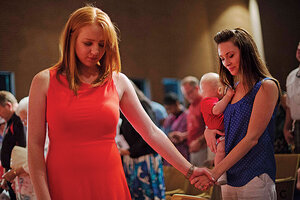To separate, strengthen, and return
Religious communities often swing back and forth -- opening their doors to the welcome the world, closing them to regain their original purpose.

FAMILIES PRAYED AT A SEND-OFF FOR AFGHANISTAN-BOUND NATIONAL GUARD TROOPS IN TOCCOA, GA., IN MAY.
DAVID GOLDMAN/AP/FILE
When a new idea catches on – a religious movement, a social cause, even just a pop-culture fad – a chart of its early days can look like a hockey stick. Growth runs at 100, 200 percent. Today, Topeka;tomorrow, the world! Doubling and redoubling is easy when you start small. Over time, though, growth gets harder. Newness fades, and the world has a way of shrugging and saying “meh” to even the most world-changing idea.
Most organized religions are in a meh phase right now (definition: lack of interest or enthusiasm) – especially traditional Christian churches. Millennials, according to opinion polls, seem indifferent to faith, churchgoing, and denominational creeds. That perhaps is a product of what researchers see as their “emerging adulthood,” in which they steer clear of commitment throughout their 20s. That could be temporary. As marriages eventually take place and children arrive, a less secular and more meaningful interest in life might bloom.
But as Mary Beth McCauley explains in a Monitor cover story (click here), religions aren’t standing still in the hopes that Millennials will show up. The fewer but more ardent believers who still go to churches, synagogues, mosques, or other places of worship tend to be more devoted, more intensely interested in spiritual community. They don’t need the world’s approval. They feel the spirit. That’s enough.
Rod Dreher, who writes about religion for The American Conservative, has for several years been talking about a modern “Benedict Option” that echoes what Benedict of Nursia did in the late years of the Roman Empire. Benedict gave up on trying to reform the meh people of Rome. They weren’t interested; their values were decadent. Why try to convince them? He created a separate, monastic movement. The idea was to live apart, to preserve essential spiritual values untainted by the world.
Mr. Dreher’s point is not that people today should join monasteries or retreat to walled compounds but that believers who disagree with the world’s current conventions and consider its current attractions corrosive should at least temporarily turn away from it. “Some sort of separation – conceptually, and to some degree literally (e.g., withdrawing to our own schools) – is necessary to maintain Christian faith and commitment amid the chaos of our time,” he writes.
Instead of following Jesus’ command to go out “into the world and preach the gospel to every creature,” people of faith could heed Paul’s command to “come out from among them, and be ye separate.” From the Mayflower Pilgrims to Shakers, Mennonites, Mormons, and hundreds of other separatist movements, believers have regularly turned away from the world. After all, the founders of all great religions invariably source their spiritual calling to their time alone in the wilderness.
But a retreat is temporary, a time to regroup to return to the world stronger. Eventually, the spiritual message must be scaled up, rolled out, tested in the marketplace of ideas. If it benefits a few, it should benefit many. Even if the world still says meh, it needs the hope the Gospel brings.

